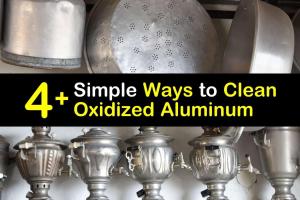Revitalize Your Aluminum: The Ultimate Guide to Cleaning Oxidized Aluminum

-
Quick Links:
- 1. Introduction
- 2. Understanding Aluminum Oxidation
- 3. Why Clean Oxidized Aluminum?
- 4. Tools and Materials Needed
- 5. Step-by-Step Cleaning Methods
- 6. Eco-Friendly Cleaning Options
- 7. Preventing Future Oxidation
- 8. Case Studies and Real-World Examples
- 9. Expert Insights
- 10. FAQs
1. Introduction
Aluminum is a popular material used in a variety of applications, from kitchen utensils to outdoor furniture. However, over time, aluminum can become oxidized, leading to a dull and unattractive appearance. In this comprehensive guide, we will explore the causes of aluminum oxidation, why it's essential to clean oxidized aluminum, and effective methods to restore its shine.
2. Understanding Aluminum Oxidation
Oxidation occurs when aluminum reacts with oxygen in the air, forming a layer of aluminum oxide. This layer can protect the underlying metal, but it often leads to a chalky, dull surface. Understanding how and why this process occurs is crucial for effective cleaning.
- Natural Process: Oxidation is a natural chemical reaction.
- Environmental Factors: Humidity, saltwater, and pollution can accelerate oxidation.
- Surface Damage: Scratches and wear can worsen oxidation.
3. Why Clean Oxidized Aluminum?
Cleaning oxidized aluminum is essential for several reasons:
- Aesthetic Appeal: Restoring shine improves the look of your items.
- Longevity: Regular cleaning can prolong the life of aluminum products.
- Functionality: Oxidized surfaces may become rough or pitted, affecting usability.
4. Tools and Materials Needed
Before you start cleaning oxidized aluminum, gather the following tools and materials:
- Soft-bristle brush
- Microfiber cloths
- White vinegar
- Baking soda
- Commercial aluminum cleaner
- Protective gloves
- Water
5. Step-by-Step Cleaning Methods
Here are several methods to clean oxidized aluminum:
Method 1: Vinegar and Water Solution
- Mix equal parts of white vinegar and water.
- Soak a cloth in the solution and apply it to the oxidized surface.
- Let it sit for 10-15 minutes, then scrub gently with a soft-bristle brush.
- Rinse with clean water and dry with a microfiber cloth.
Method 2: Baking Soda Paste
- Combine baking soda with water to form a paste.
- Apply the paste to the oxidized areas and let it sit for 30 minutes.
- Scrub with a soft brush and rinse thoroughly.
- Dry with a microfiber cloth.
Method 3: Commercial Aluminum Cleaner
- Follow the manufacturer's instructions on the cleaner.
- Apply the cleaner to the oxidized areas.
- Scrub gently and rinse with water.
- Dry with a microfiber cloth.
6. Eco-Friendly Cleaning Options
If you're looking for environmentally safe alternatives, consider the following:
- Citric Acid: Mix with water to create a natural cleaner.
- Olive Oil: Can help restore shine when buffed into the surface.
7. Preventing Future Oxidation
Taking proactive steps can help prevent oxidation:
- Store aluminum items in a dry place.
- Avoid exposure to harsh chemicals.
- Regularly clean and polish aluminum surfaces.
8. Case Studies and Real-World Examples
Real-world examples illustrate the effectiveness of various cleaning methods:
Case Study 1: Restoring an Aluminum Patio Set
After using vinegar and baking soda, a homeowner successfully restored their 10-year-old patio furniture, reviving its original luster.
Case Study 2: Kitchen Utensils
Using a commercial cleaner, a chef was able to bring back the shine of their aluminum cookware, improving performance and aesthetics.
9. Expert Insights
We reached out to cleaning experts for their recommendations:
"Preventing oxidation is easier than cleaning it. Regular maintenance saves time and effort later." - Cleaning Expert Jane Doe
10. FAQs
1. Can I use bleach to clean oxidized aluminum?
No, bleach can damage aluminum surfaces.
2. How often should I clean my aluminum items?
Regular cleaning every few months is recommended for outdoor items.
3. Is it safe to use steel wool on aluminum?
No, steel wool can scratch and damage aluminum surfaces.
4. What is the best homemade cleaner for aluminum?
A mixture of vinegar and baking soda works effectively.
5. Can I prevent aluminum oxidation?
Yes, by storing items properly and avoiding harsh chemicals.
6. How can I shine aluminum after cleaning?
Use a small amount of olive oil to buff the surface.
7. Are there any commercial products you recommend?
Look for aluminum-specific cleaners and polishes available at home improvement stores.
8. Is it necessary to wear gloves while cleaning?
It is advisable to protect your hands, especially when using commercial cleaners.
9. What if my aluminum is severely oxidized?
Consider professional cleaning services for extensive damage.
10. Can I use a pressure washer on aluminum?
A pressure washer can be used, but with caution to avoid surface damage.
Random Reads
- How to sync google contacts with android
- How to remove mold from bags
- How to remove mold from drywall
- How to install a water softener
- How to install a washing machine
- How to find suicune in pokemon heartgold soulsilver
- How to delete mobile legends account
- How to delete file using command prompt
- How to apply thermal paste
- How to apply tung oil